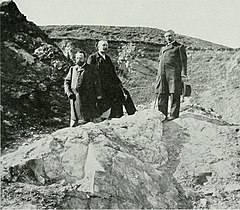Carl Hintze
 | |
| Data i miejsce urodzenia | |
|---|---|
| Data i miejsce śmierci | |
| Zawód, zajęcie | geolog, mineralog |
Carl Hintze (ur. 17 sierpnia 1851 we Wrocławiu, zm. 28 grudnia 1916 tamże) – niemiecki geolog i mineralog, profesor Uniwersytetu Wrocławskiego.
Życiorys
W 1886 został profesorem mineralogii, a od 1892 także dyrektorem Instytutu Geologii i Paleontologii Uniwersytetu Wrocławskiego i był nim do śmierci w 1916 (po podziale tego Instytutu na dwa odrębne instytuty w 1897 objął kierownictwo nowo powstałego Instytutu Mineralogicznego).
Główną pracą Carla Hintzego była monumentalna monografia licząca 5000 stron: Handbuchs der Mineralogie (poszczególne tomy wydawano w: 1889, 1897, 1904, 1910, 1915, 1930, 1933; dwa ostatnie pośmiertnie; tomy powstałe później są autorstwa innych badaczy).
Upamiętnienie
Na cześć badacza nazwano odkryty w 1978 minerał nazwą carlhintzeit.
Bibliografia
- M. Mierzejewski, M. Sachanbiński & Z. Wierzbicki, 2003: Zarys historii nauk mineralogicznych i geologicznych na Uniwersytecie Wrocławskim w latach 1811-1945. W: A. Grodzicki (red.): Historia nauk geologicznych na Uniwersytecie Wrocławskim. Wyd. Uniwersytetu Wrocławskiego. ISBN 83-229-2419-4
Media użyte na tej stronie
Autor: Internet Archive Book Images, Licencja: No restrictions
Jade quarry in Jordansmuhl, Silesia
Title: The American Museum journal
Identifier: americanmuseumjo17amer (find matches)
Year: c1900-(1918) (c190s)
Authors: American Museum of Natural History
Subjects: Natural history
Publisher: New York : American Museum of Natural History
Contributing Library: American Museum of Natural History Library
Digitizing Sponsor: Biodiversity Heritage Library
View Book Page: Book Viewer
About This Book: Catalog Entry
View All Images: All Images From Book
Click here to view book online to see this illustration in context in a browseable online version of this book.
Text Appearing Before Image:
Quarry at Jordansmiihl, Silesia, where the largest block of jade ever mined was discovered in 1899. Although people familiar with Jordansmiihl were skeptical as to the chances of obtaining jade specimens of note in a spot where quarrying had been going on since Roman times, a search of less than a day was rewarded by the discovery of a jade block weighing between two and three tons. The cross indicates the original position of the mass
Text Appearing After Image:
V A near view of the original resting place of the jade block of Jordunsniulil, now exhibited in Memorial Hall of the American Museum of Natural History. To the left is seen Dr. Carl Hintze, of the University of Breslau, Germany, through whose courtesy was made possible the acquiring of this remarkable specimen 143
Note About Images
